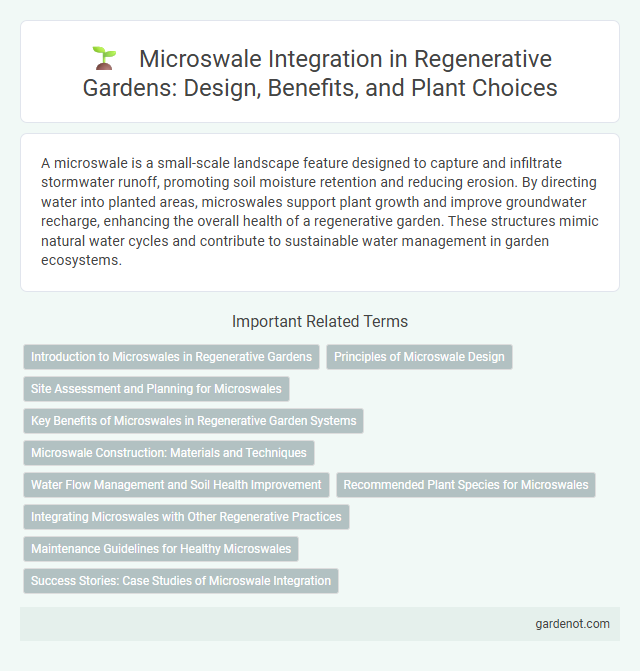A microswale is a small-scale landscape feature designed to capture and infiltrate stormwater runoff, promoting soil moisture retention and reducing erosion. By directing water into planted areas, microswales support plant growth and improve groundwater recharge, enhancing the overall health of a regenerative garden. These structures mimic natural water cycles and contribute to sustainable water management in garden ecosystems.
Introduction to Microswales in Regenerative Gardens
Microswales are shallow, contour-following trenches designed to capture and infiltrate rainwater, enhancing soil moisture and reducing erosion in regenerative gardens. By slowing runoff and directing water into the earth, microswales promote healthier plant growth and improve groundwater recharge. Implementing microswales helps restore natural water cycles and supports sustainable landscape management.
Principles of Microswale Design
Microswales harness gravity and soil permeability principles to capture and infiltrate rainwater, reducing runoff and promoting groundwater recharge. Their design emphasizes contour alignment, adequate spacing, and appropriate sizing based on landscape slope, soil type, and expected rainfall. Incorporating vegetation within microswales enhances water retention, prevents erosion, and supports biodiversity in regenerative gardens.
Site Assessment and Planning for Microswales
Effective site assessment for microswales involves analyzing topography, soil type, and drainage patterns to determine optimal placement and dimensions. Planning includes mapping contour lines and identifying runoff sources to maximize water capture and infiltration. Proper assessment ensures microswales enhance soil moisture retention and reduce erosion in regenerative garden designs.
Key Benefits of Microswales in Regenerative Garden Systems
Microswales enhance water retention by capturing and directing rainfall into the soil, reducing erosion and promoting groundwater recharge in regenerative garden systems. They support plant health by maintaining consistent moisture levels, which increases biodiversity and soil fertility. By slowing runoff, microswales prevent nutrient loss and create microhabitats that encourage beneficial microorganism activity.
Microswale Construction: Materials and Techniques
Microswale construction involves shaping small, shallow channels to capture and infiltrate rainwater, using natural materials such as mulch, compost, and locally sourced soil to enhance moisture retention and soil fertility. Techniques include contouring the land to follow natural slope gradients, installing infiltration basins, and reinforcing edges with stones or organic matter to prevent erosion. Proper layering and compaction ensure durability, while planting native vegetation within and around microswales promotes biodiversity and improves microclimate conditions in regenerative gardens.
Water Flow Management and Soil Health Improvement
Microswales enhance water flow management by capturing and directing rainfall runoff into the soil, reducing erosion and promoting groundwater recharge. These shallow, contour-aligned trenches slow water movement, allowing deeper infiltration and improving soil moisture retention. The increased soil hydration supports microbial activity and nutrient cycling, essential for healthier, more resilient garden ecosystems.
Recommended Plant Species for Microswales
Recommended plant species for microswales include deep-rooted native grasses such as switchgrass (Panicum virgatum) and sedges like Carex spp., which enhance water infiltration and soil stabilization. Complementary plants such as wildflowers (Echinacea purpurea) and shrubs like elderberry (Sambucus canadensis) support biodiversity and improve habitat quality within the microswale ecosystem. Selecting drought-tolerant, erosion-resistant species ensures long-term resilience and effective stormwater management in regenerative garden designs.
Integrating Microswales with Other Regenerative Practices
Integrating microswales with regenerative practices such as contour planting and swale-based water harvesting enhances soil moisture retention and erosion control. Combining these techniques supports native plant growth while improving groundwater recharge and biodiversity. This synergy maximizes landscape resilience and promotes sustainable ecosystem health.
Maintenance Guidelines for Healthy Microswales
Regular inspection of microswales ensures optimal water infiltration and prevents erosion by clearing debris and sediment buildup. Maintaining native vegetation within the swale stabilizes soil, improves water retention, and supports local biodiversity. Periodic reshaping of swale contours preserves proper flow patterns, avoiding water pooling and promoting effective runoff management.
Success Stories: Case Studies of Microswale Integration
Microswales have proven effective in regenerative gardens by significantly improving water retention and reducing soil erosion, as demonstrated in case studies from California and Australia where drought-prone areas saw increased vegetation growth and enhanced soil health. In a notable project in Santa Barbara, microswale integration resulted in a 30% increase in native plant survival rates, showcasing their capacity to restore degraded landscapes. These success stories emphasize microswales' role in creating resilient ecosystems and promoting sustainable water management in urban and rural regenerative gardening projects.
Microswale Infographic

 gardenot.com
gardenot.com